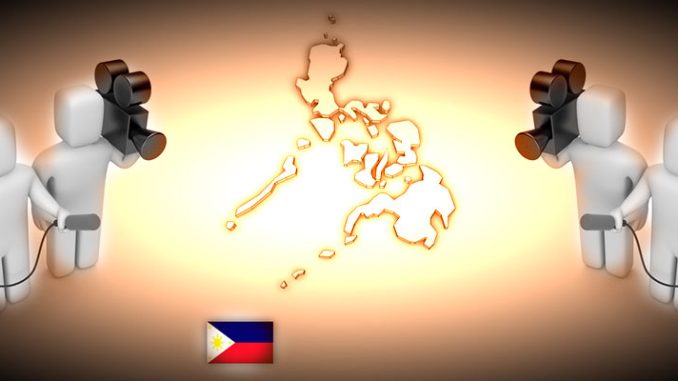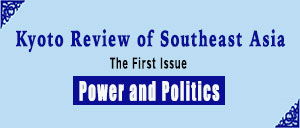
Kyoto Review recently spoke with Marites Dañguilan Vitug, prominent Philippine journalist and editor of the newsmagazine Newsbreak, who writes on issues ranging from the Philippine military and everyday politics to Islam and the Southeast Asian region. We asked her about national politics one year into the term of President Gloria Macapagal Arroyo, recent developments in the southern Philippines, and the state of Philippine journalism.
Elections, Uprisings, and Democracy
Kyoto Review: The Philippines has been described as having the “freest” elections in Southeast Asia. Some see this a sign of a thriving—though imperfect—democracy, while others cite the Philippines as an example of “too much” freedom leading to chaos. The 1986 revolution toppling Ferdinand Marcos and the 2001 ouster of Joseph Estrada, dubbed EDSA 1 and EDSA 2, have added another element to national politics: the use of uprisings to replace political leaders and, some say, “enhance” the democratic process. What do you think will be the relationship between elections and uprisings in the future? And in light of EDSA 3, the attempted uprising against Arroyo in May 2001, isn’t the uprising a more destabilizing than enhancing factor for Philippine democracy?
Vitug: It’s time to build and strengthen institutions in the Philippines. Of course, this has been a long-time concern, but it’s high time to stress the importance of shoring up confidence in institutions. After two EDSAs, which have been critical and continue to be important in our history and in our public politics, another uprising will be destabilizing. I agree that Philippine democracy will become more fragile, rather than be enhanced, by another EDSA-type event. The military will be flirting, once again, with power and the idea of gaining it. The political equation will be skewed in their favor, making the president beholden to them, in a way. The media, which are largely reckless, will be speculating on coup plots. The threat of replacing a leader through mass protest will always hang heavy. All these will make for political uncertainty.
To a certain extent, the two EDSAs have taught us lessons in choosing leaders. But these have not yet translated into wise and intelligent voting patterns. Thus, the most pressing issues that relate to elections are: 1) educating the voters, and 2) making the electoral process as fraud-free as possible, using technology, a credible Commission on Elections, and reputable watchdogs.
A problem, however, in the institution-building process is the way the public regards some of these institutions. For example, petty and highly partisan politics are damaging the Senate. It has allowed itself to be the venue for high-profile investigations that are better left to the judiciary. Parochial and personal interests color the confirmation of Cabinet appointees.
Kyoto Review: What would it mean to “translate” the lessons of the two EDSAs into “wise and intelligent voting patterns”? A striking thing about the Senate is the diversity of people chosen in national, at-large elections. In the present Senate, there are actors and basketball players, human rights advocates and nationalists, old and new political elites, leaders of notable background and those whose careers have been quite controversial. How would you account for this?
Vitug: Never has media played such a critical role in the choice of senators. By this I mean personalities who have achieved some celebrity by appearing regularly on television, particularly anchor persons with ABS-CBN, the largest TV-radio network in the Philippines. Loren Legarda is an example, followed by Noli de Castro. Neither have experience in legislation or national or local leadership. But they won on sheer popularity after years of national exposure. Francisco (Kiko) Pangilinan used to have a public affairs show in ABS, apart, of course from his show business connections (being married to popular singer-actress Sharon Cuneta). Two congressmen, Ted Failon and Gilbert Remulla, were also faces at ABS. Failon was a TV anchor and radio host, Remulla a reporter. This phenomenon has made Sen. Edgardo Angara remark that ABS-CBN is a political party to contend with.
Similarly, incumbents and those with well-known family names make it, for example, Ramon Magsaysay, Jr., John and Sergio Osmeña, Franklin Drilon. Name recall works in powerful ways. By virtue of their many years in national politics (Drilon, Juan Flavier) and those of their parents and relatives (the Osmeñas, the Magaysays), their names are etched in voters’ minds. They have also built select constituencies while in office, for example, teachers and senior citizens in the case of Edgardo Angara. Panfilo Lacson built quite an image as a no-nonsense tough cop who cleaned up the police of mulcters [police who actively solicit pay-offs—ed.]. Perception is not necessarily based on reality but Lacson deftly projected a Mr. Clean image. Thus, much of the criticism against him did not stick. The phenomenon of polls and surveys has also helped steer candidates to victory. If properly used by their strategists (as in the case of Lacson and Gregorio Honasan), survey results were able to guide campaign plans.
Kyoto Review: EDSA 1 had a clear “leader” in Cory Aquino to counter-pose against Ferdinand Marcos. It is not clear whether the EDSA 2 forces accorded Gloria Macapagal Arroyo the same stature. Does this partly explain the difficulties of Arroyo’s first year in office?
Vitug: EDSA 1 was easy to explain in terms of good vs. evil. Cory Aquino and Ferdinand Marcos were opposites. Philippine society was polarized, and no one could afford to stay in the middle. The issues had built up through many years, since martial law was proclaimed in 1972. Human rights abuses were brutal. State repression was severe.
Gloria Macapagal Arroyo didn’t offer as sharp a contrast to Joseph Estrada. For one, she’s a politician, not pure in the sense that Cory was. Another reason: Estrada wasn’t hated as much as Marcos was. It was abuse of power and hubris in Estrada’s case, absence of work ethic, but no mass killings (except for the war policy against the Moro Islamic Liberation Front), no repression, no dictatorship. Also, Estrada still enjoyed a mass following, unlike Marcos whose loyalists were limited to his province.
The people who went to EDSA 2 wanted Erap out but many were not sure of Macapagal Arroyo as successor. Not because of corruption scandals, but because of her record as a political butterfly, having switched from one party to another. Once, when asked who had a major influence on her in politics, she cited a number of politicians: Ed Angara, Ernie Maceda. Not very noble, really. There was also the perception that she’s not a good person, that she has a mean streak in dealing with people. And there was talk about her husband, Mike, being a wheeler-dealer. But since there was no other alternative, they went for her. Better Gloria than Erap. Better anyone than Erap.
But Arroyo’s difficulties in the first year had to do more with the perception that she was brought into power by the middle and upper classes. Thus, EDSA 3 happened, where the poor rallied around pro-Estrada politicians. Estrada left a legacy of style and image rather than substance. Macapagal Arroyo had to go the same route of projecting empathy with the poor.
Kyoto Review: How would you evaluate so-called “civil society” groups in light of EDSA 2 and EDSA 3? Do these groups still have influence in Philippine politics or have they become simply reinforcements or even props for competing power blocs?
Vitug: “Civil society” groups encompass quite a variety of organizations representing diverse views in the political spectrum. EDSA 2 was middle- and upper-class, the Church, political parties, and business. EDSA 3 was the poor and opposition political parties. Definitely, they influence Philippine politics.
EDSA 2 saw a convergence of interests. It would be unfair to say that these groups were simply props to competing power blocs, although they reinforced the Catholic Church and the Makati Business Club. Some of them now have the ear of the President and the Cabinet and had a say in some of the appointments. After all, ex-civil society leaders now sit in the Arroyo Cabinet, for example Department of Social Work and Development Secretary Dinky Soliman and National Anti-Poverty Commissioner Teresa Deles.
In the case of EDSA 3, they jolted the Arroyo government into addressing the needs of the poor, both in style and substance. EDSA 3 clearly showed that the poor were up for grabs, easily galvanized by a fallen idol, plus cash. But their anger was for real and the issues that propelled them to the streets are just as real.
The Abu Sayaff, the Americans, and the Philippine Press
Kyoto Review: Can you explain the disjuncture between raging debates over American “intervention” in southern Mindanao and the potential of another Vietnam war, on the one hand, with 83% public approval ratings, on the other? Is this evidence of a colonial mentality or is it the pragmatism of a people tired of wars, civil conflicts, and excessive politicking?
Vitug: It shows a country divided over the issue of a US presence in Mindanao. But this time, the majority welcome American troops. It’s because of low trust in the military and disgust with the Abu Sayyaf. Underneath all this is still a liking for America and confidence that, with its training, technology, and equipment, the US can crush this dreaded group that the Philippine military has been unable to defeat. Imagine 5,000 to 6,000 soldiers in Basilan for the last nine months—with little to show for it!
But I think the welcome will last only a short time, perhaps six months, and not for an extended period. It can get complicated.
Kyoto Review: The 13 February 2002 issue of Newsbreak carried the story “Mindanao is the Backdoor to Southeast Asia.” Your writer, Manny Mogato, pointed out that Indonesia is really what the United States is interested in. Why do so few people in the Philippines pick up on the regional dynamics of the American presence in southern Mindanao?
Vitug: Many in the Philippines think parochially, including the press. This lack of interest in our neighbors can be frustrating. The story on the Southeast Asian terror network included the arrest of an Indonesian in this country who admitted having taken part in the bombings of the [Manila] LRT stations in 2000, and the seizure of explosives belonging to this group in Gen. Santos City, yet the local press didn’t give it prominence—and coverage lacked the context of what’s happening in the region. I am not sure if this regional context was part of the debates or discussions in the Cabinet. No Arroyo officials were quoted on this regional angle.
Kyoto Review: The Philippines is listed in the top five countries with the most newspapers, newsmagazines, etc. Where do you situate your newsmagazine in this myriad of publications and what sort of impact do you hope to have?
Vitug: There are three weekly news and current affairs magazines in the country: Graphic, Free Press, and Newsbreak. The first two have an old history. We’re the youngest—and we’ve recently turned fortnightly. It would be self-serving to describe ourselves vis-a-vis the competition. But one thing is clear: We want to be the most credible and authoritative source of news and analysis in the country. If we successfully carve out this niche, then we’re able to help shape policy and decision-making in government as well as the private sector. Moreover, we want to show that Philippine media need not be part of the problem; we, too, can be part of the solution, by bringing clarity to issues and elevating national debate to subjects that matter.
Daily newspapers in the country are not doing a good job of reporting. Nothing in my mind comes up as a counterpart to The Bangkok Post. There’s a vacuum to be filled.

